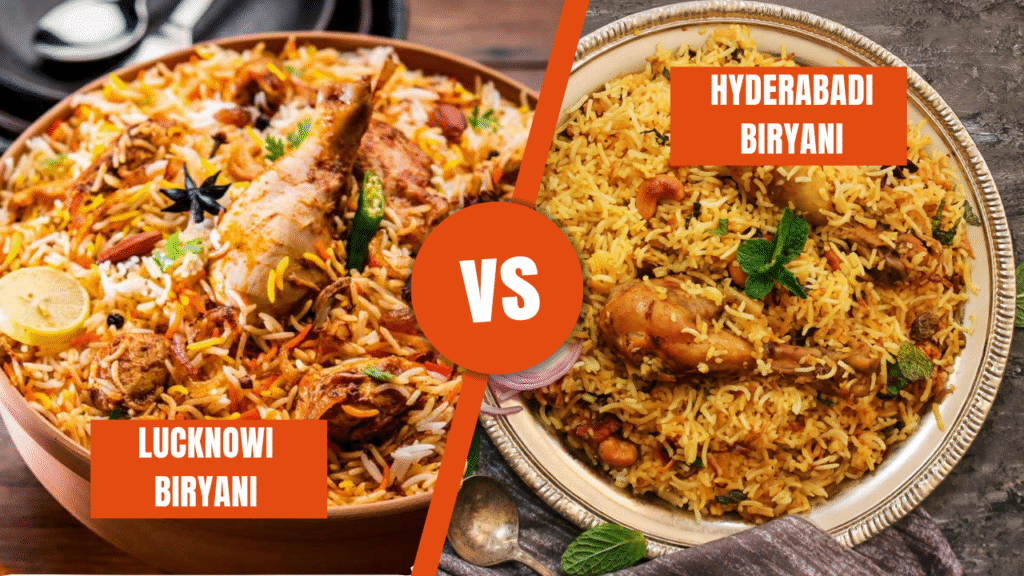Biryani—arguably the crown jewel of biryani Indian food—is more than just a rice dish. It’s a cultural statement, a culinary experience, and in India, it’s a matter of pride for many regions. Among all the local versions, Hyderabadi and Lucknowi (Awadhi) biryanis are two of the most iconic, each offering a unique journey for your taste buds. So which one reigns supreme? Let’s explore how each style shapes flavor, preparation, and regional identity in India’s rich culinary landscape.
Cooking Techniques: Kacchi vs Pakki
Hyderabadi biryani is made using the kacchi (raw) method, where marinated raw meat is layered with partially cooked rice and then sealed and cooked together in a heavy-bottomed vessel. This traditional ‘dum’ technique allows the meat’s juices and spices to permeate the rice, resulting in a deeply flavorful dish. Every grain is infused with the essence of spices and meat, creating a bold and integrated flavor.
Lucknowi biryani, on the other hand, employs the pakki (cooked) method. Here, both the meat and rice are cooked separately before being layered together. The pre-cooked meat is typically stewed in a delicately spiced broth, and then combined with rice that’s often infused with aromatic ingredients like saffron, rose water, or kewra. This method allows for more control over individual elements and yields a biryani that is elegant and refined in taste.
Check Out: High Protein Indian Recipe: Wholesome Palak Saag Thali You’ll Love
Flavor Profiles: Bold vs Aromatic
The flavor difference between the two biryanis is striking. Hyderabadi biryani is known for its rich, fiery, and complex flavors. Ingredients like fried onions, red chili powder, garam masala, and yogurt contribute to its intense depth. The dish often has a spicier punch, appealing to those who enjoy a bolder palate.
In contrast, Lucknowi biryani is celebrated for its subtle, aromatic, and sophisticated profile. It relies on whole spices like green cardamom, cinnamon, cloves, and bay leaves, paired with floral hints from rose and kewra essence. The result is a biryani that feels royal, refined, and more delicate on the tongue.
Meat Preparation and Rice Texture
The treatment of meat is another major differentiator. In the Hyderabadi style, meat (usually mutton or chicken) is marinated for several hours with a mix of yogurt, ginger-garlic paste, and a robust blend of spices. This ensures that the meat becomes juicy and flavorful during the slow-cooking process.
Lucknowi biryani meat is usually pre-cooked in a fragrant broth and then layered with rice. The result is meat that is incredibly soft, tender, and subtly flavored. Both styles use premium long-grain basmati rice, but in Hyderabadi biryani, the rice is kept slightly firm to absorb the meat’s juices during steaming. In Lucknowi biryani, the rice is more uniformly soft due to being pre-cooked and layered after the broth-infusing step.
Regional Influence and Culinary Legacy
Hyderabadi biryani is heavily influenced by the culinary traditions of the Nizams and showcases the spices and methods native to the Deccan plateau. It represents the fiery spirit of southern Indian food with its bold use of spices and flavors.
Lucknowi biryani finds its roots in the royal kitchens of Awadh, where culinary refinement was paramount. It reflects the Nawabi culture of North India, focusing on finesse, aroma, and elegance. The dish is a testament to the Mughal legacy, with its subtle notes and layered approach to taste.
Check Out: Thalis Indian Food Experience: Discover the Magic of Flavor, Balance, and Tradition
Which One Deserves a Place on Your Plate?
If you love bold and spicy flavors that hit you from the first bite, Hyderabadi biryani is the clear winner. But if you appreciate subtler nuances, fragrant spices, and a more royal touch, Lucknowi biryani will not disappoint. In truth, both styles are masterpieces of biryani Indian food, and trying each version is the only way to fully appreciate their unique characteristics.
Whether you’re dining at a heritage restaurant or cooking at home, understanding these regional variations enriches your food experience and brings you closer to India’s diverse culinary story.
For More Indian Food Stories
Check out our food section: https://indian.community/category/indian-food/
